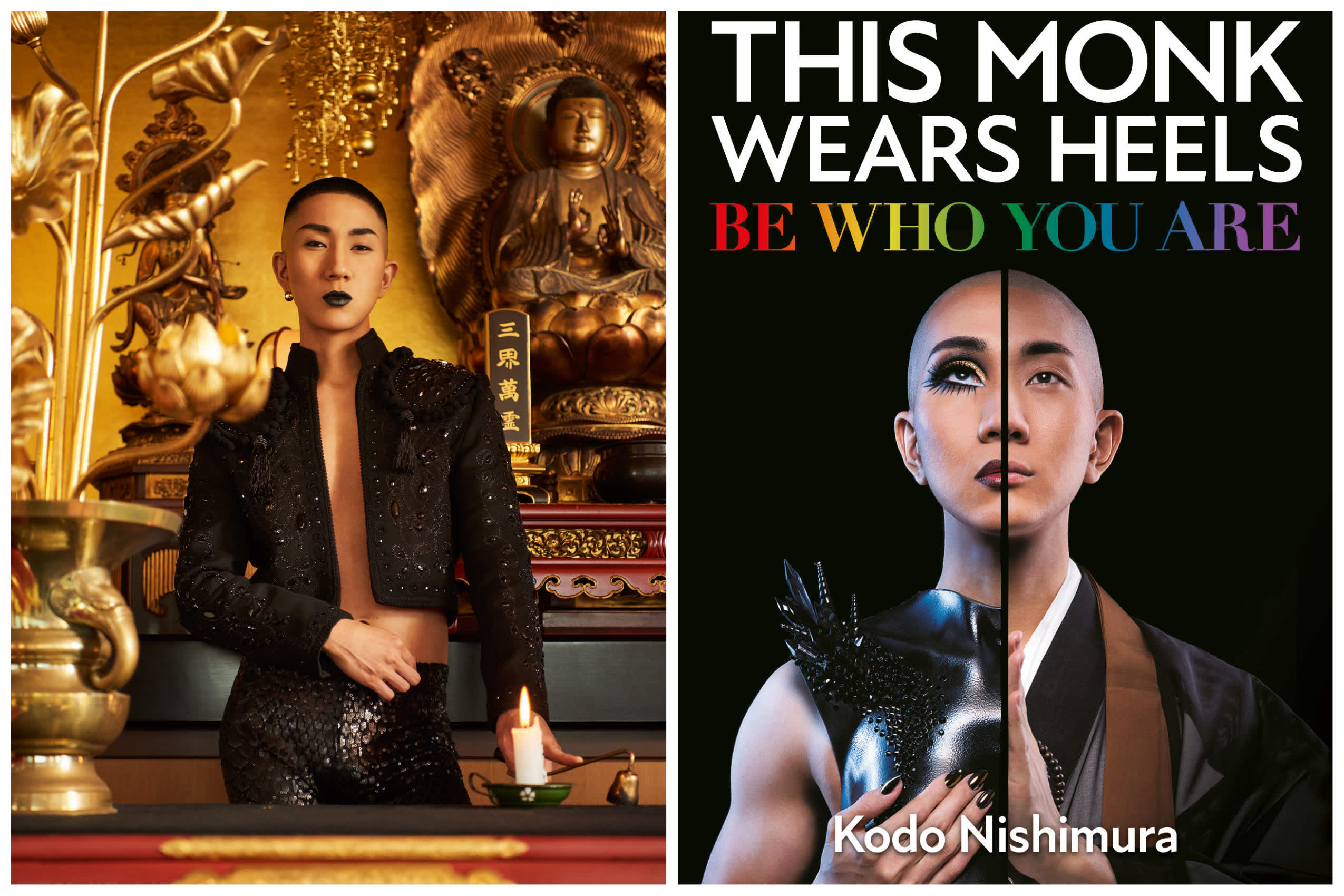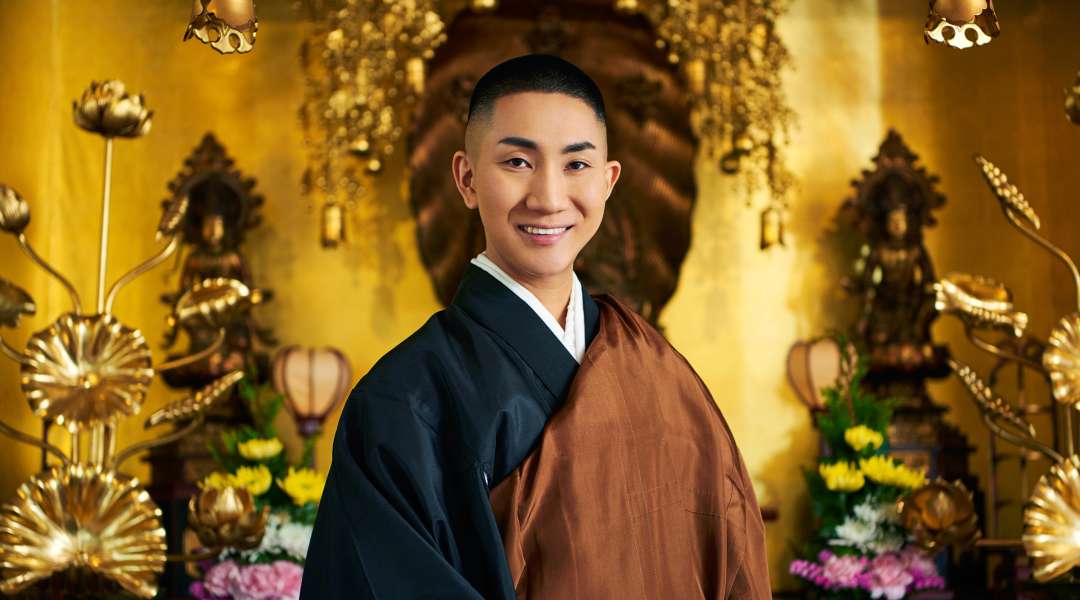
Kodo Nishimura was born in a Buddhist temple in Tokyo and struggled with his identity while growing up in Japan and, later on, studying in the US. You might recognise him from Netflix's 'Queer Eye: We're in Japan' where he appeared in the second episode. Following its release, Kodo became an international star and since then he's been featured in TIME Magazine's 2021 Next Generation Leaders line up, and many other spaces. He's a Buddhist monk, makeup artist, and an LGBTQ+ activist encouraging people to unapologetically be who they are. Kodo's new book 'This Monk Wears Heels: Be Who You Are', a successful combination of self-help book and memoir, is a must-read for everyone trying to find themselves in the modern world. The book came out in English in February 2022 and you can get your own copy here.

Hi Kodo, thank you for agreeing to have a chat with us. Could you tell us a bit about yourself?
My name is Kodo Nishimura. I am a Buddhist monk, a makeup artist, and also an LGBTQ activist. In a world where people are still expected to conform to what is “normal”, I use Buddhism and beauty to help people to be their authentic selves. I was born in a Buddhist temple in Tokyo. I used to struggle with being homosexual and the expectation that I would follow the traditional image of a monk. After working as a makeup artist in New York, I had a better understanding of myself. I came back to Japan and joined the monk training. There I found a Buddhist scripture which says Buddhism supports diversity. I met a master who taught me that being my authentic self is nothing wrong. Now I want to help people who feel limited. By talking about Buddhism and amplifying people with makeup, I want to encourage people to confidently be who they are.

Ever since you were featured on ‘Queer Eye: We’re in Japan’ you have become a public figure. Have you found any unexpected or surprising changes in your life?
People talk to me in the least expected places! Once I was in Thailand working for the Miss Universe pageant. We were at a restaurant, and I went to use the restroom. When I washed my hands, I realized that I’d forgotten a handkerchief, so I was about to flick my hands hard to dry them…Suddenly a local security guard, who was washing his hands next to me, said, “You are the makeup artist and a monk right?!” It was an awkward moment! That’s when I learned that I could be recognized at any moment … and that I should not forget my handkerchief!

We thoroughly enjoyed reading your book ‘This Monk Wears Heels’. What inspired you to write it in a self-help book format?
I love self-help books because these books have helped me to be hopeful. For example, when I was 18, I used to feel inferior because of my ethnicity. I believed that a Japanese person can never feel beautiful in the global setting. But I found a book about a Japanese woman winning Miss Universe. The author talked about finding confidence even if we don’t have blue eyes or blonde hair, and conquering the world. So at this time, I want to help people find their own confidence regardless of any differences such as sexuality, wealth or religious values. I quote Buddhist sutra that says shining in our own color is beautiful.

In the book, you mentioned that you’re a part of the LGBTQ+ community but rather than with any of the letters, you like to identify yourself as ‘gender gifted’. Could you explain what you meant by this to our readers?
I identify myself as "gender gifted" because I feel that I am both male and female. My body is male, but I express myself freely. I also identify myself as a female, and I feel that females are my peers spiritually. I am not bound by the category of men nor women, and I can inspire others to think beyond those boundaries. Our body might have a gender, but I believe that one’s spirit does not have a gender.

How has not being what many would consider ‘the traditional Buddhist monk’ allowed you to help people and create positive change?
I am able to give people an opportunity to rethink the traditional notions of what a monk does and how he lives. The role of a Buddhist monk is not to preserve the traditional image and live a limited life, but really to help people to go beyond such limits. When I focus on this most important purpose, I believe I can inspire people to seek the truth and evolve from values that may be harming them.

What advice would you give to LGBTQ+ visitors planning their first trip to Japan?
I would advise you to enjoy the food and the sights regardless of your sexuality. Japan is relatively safe. My Spanish friend said that he felt free to wear what he wanted to wear. In some countries you can be victimized if you wear vivid clothes, but I would say Japan is pretty accepting in that sense. Remember Harajuku, the area of Tokyo where people are so colorfully dressed.
On the other hand, I would love you to talk about your experiences to Japanese people you meet. Japanese people still need to be educated about LGBTQ+ realities in the world. I think visitors can greatly help the people of Japan to have a broader view.

Do you have any recommendations for people who are looking for an inclusive Buddhist experience during their stay?
I would recommend they visit various temples in Japan. Buddhism was created against discrimination. Siddhartha Gautama, the founder of Buddhism, did not comply with the caste system in India. The Japan Buddhist Federation has issued a rainbow sticker (designed by me!) to be displayed at temple entrances, and some temples have started performing weddings for homosexual couples. So I am proud to say that Buddhism welcomes you, just as you are!
You can buy Kodo's book here or say hello to him on Instagram.
Or you can find out more about the chance to experience a slice of that Buddhist life Kodo was describing through Mount Koya, Japan's most sacred mountain, here.


























































